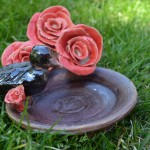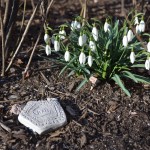The Joy of the Journey
At the beginning of the semester, Professor Asani challenged my Culture and Belief class with the question:
“How do you know what you know about religion?”
This was a tough question for me. I had never really thought about it before. Other questions started circulation in my head: why had I gravitated to this introductory course on Islam? What were the stereotypes that I was holding onto about Muslims? What did I hope to learn?
The answer to those questions now is represented in this blog.
What follows is one 21-year-old’s exploration of Islam. Never having had much exposure to Islam growing up, I had foggy and fuzzy ideas of what being Muslim entailed. Through these six creative pieces I explored different concepts of the Islamic faith and tradition through a wide range of mediums. While intellectually I learnt a lot about Islam through the lectures, readings and discussions, I feel that these creative projects have allowed me to experience and engage with Islam in a personal way, giving me a more profound understanding of the religion.
My creative piece, “Road tripping with religion” looked at religion as being a journey, with many different routes leading to the experience of God. In the Sufi tradition there is a concept of tariqah, which is a mystical path, way or method that the believer follows in order to achieve ḥaqīqah, which is the “real” or ultimate truth.[1] There are many different stages, and it is a process of learning that cannot be undertaken by oneself. The role of the guide or sheikh is very important. Although there is no profound meaning or lesson to be learned from my blog, I equally feel that without guidance or explanation, you, its reader, will get lost. In the next few paragraphs I hope to demystify elements from it, and take you on a journey of my creative endeavors over the last few months.
In my art projects I explored new mediums that I had never tried before. There was a wonderful parallel between my entering blind into the world of Islam, and embarking on projects where I didn’t have that much technical skill. As I went about firing my first clay piece, figuring out what paint was best to use on canvas, and how to capture still life photographs –I was also taking introductory steps in the classroom, learning about the five pillars of Islam, and meeting Rumi for the first time. As a beginner in both the creative and academic aspects of this journey, this process was a rewarding adventure into unknown territory.
Although my pieces vary from music videos on ethereal concepts, to specific depictions of poems that I connected with, there is a common theme of multiplicity and interpretation in the way I chose to display my projects on the blog. I took each of my pieces and photographed them from different angles, and often in different settings, to show how there could be numerous interpretations. This resulted in many different views of the same project, which often looked completely different depending on how they were photographed. Together each photo grid provides a window into the different stages of my creative experience, giving the viewer a more nuanced view of the process. In this course, which had a strong focus on how art and literature could be used to represent different interpretations of Islam, I wanted to stress the importance of looking at objects and ideas in multiple ways.
This central idea of the plurality of Islam was reflected in my blog post about Islam being similar to a saltcellar. I wanted to stress how religion can be a transformative element in people’s lives but that it can flavor, instead of completely alter, people’s already existing cultural traditions. This was apparent when looking through the many different styles of mosques for the Mosque project. The basic architecture and design was similar, but the ornamentation, style, decoration and materials used, reflected the different cultural influences of the regions. Just as with food, I feel that Islam accommodates different understandings in different settings. In an article by Daftary, he discusses the origins of the diversity in Islam and the multiple “communities of interpretation.”[2] It is important to realize that “Islam” is an umbrella term for a whole host of different Islamic interpretations. The distinction between Sh’ia and Sunni, merely skims the surface of a much wider pool of interpretations. Yet despite these variations, the ideological base is the same, and the teachings of the prophet, the hadiths, and the Quran link these groups of people. As Daftary points out, the plurality of Islam needs to be acknowledged and celebrated in order to assure harmony for the future generations of Muslims in our quickly globalizing world. My saltcellar is covered with calligraphy and Islamic designs to symbolize how Muslims have the same overarching beliefs. However the use of the salt amongst the different people at the dinner table is not uniform, and shows the plurality of the Islamic tradition.
This course has shown how arts and literature have expressed the different faces of Islam, but it has also explored how these creative mediums mark the similarities. Plays like the Taziyeh describing the battle of Karbala, tell an important narrative for Shi’ah Muslims all over the world. They are connected by Hussein’s act of sacrifice, and he is a symbol of good triumphing over evil. My creative project of a turbah stone was an exploration of how these stories can be represented in physical form. The turbah is used by many Shi’ah Muslims in prayer. The incorporation of this stone as part of this fundamentally Islamic practice five times a day shows how these cultural pieces live past the boundaries of merely being art and are used in practical day-to-day living as well.
The tradition of the Taziyeh originated centuries ago. A lot of the literature, poetry and artwork that we looked at in the course went back hundreds of years and when I first glanced at the syllabus I thought that I would not be able to relate to all these old and translated pieces of work. However, like I mention in my piece on the nightingale and the rose, thinking about these works in terms of creative projects and being open to their lessons, allowed me to find universal truth in their messages. This ability to transcend space and time is testimony to the important role of literature and art in helping capture the experience of religion. The use of poetry and the power of its words in society for me was a new experience, and showed me the beauty and richness of Islam.
This course put a lot of emphasis on experiential learning, showing films, music videos, and recitations of poetry, chants and singing. In a way because of this, I thought that it was appropriate to do a piece that shows experiential forms of devotion. The whirling dervishes were a good example of believers who found connection with God through movement to music and poetry. This was controlled and structured, but at the same time shows how worship is an expression that can take many forms. Muslims believe that “dikhr” loosely translated as “remembrance”, needs to take place in order to remember God and can take the form of different devotional acts. What Sufis stress, especially when up against criticism for the music and dance associated with their practices, is the intention of the performer and audience of the event. Participation revolves around the purity of intention of the people involved, with the desired state being that “the listener is totally longing for God and not at all longing for the created.”[3] This emphasizes how both the person engaging in the art form, as well as the person appreciating it are actively engaged in an experience which is helping them become closer to God. I found this particularly poignant, especially since I felt that I could relate to it because I felt very invested in a lot of the creative work I did for this class.
Following the desire to experience what Islam meant, I decided to engage in a creative piece where I dressed in a hijab and walked around Harvard to get a sense of what this felt like. As a woman living in a modern, Western society it was a way of my trying to understand what being female in a more patriarchal and traditional system would be like. It made religion real for me, as my hijab shouted to passersby ‘my’ system of beliefs and ways of living. Although in many ways strange, it made me realize that Islam wasn’t as foreign as I thought, and I could directly relate to Muslim women.
This was one of the last projects that I did and it marked the progression of the semester. In the beginning, Islam was a confusing and distant concept. I felt comfortable engaging with it from afar, through the books and newspaper articles that I read. It was not something that I could personally connect to. However through the music, plays, stories, art, creative projects and discussions this semester, Islam is no longer limited to foreign ideas. I have engaged with it, experienced parts of it, and creatively reinterpreted it in my own ways. This blog is not only a collection of ideas, it is representative of my new acquaintance with Islam.
Like the road trip that I went on with my sister over the summer, I embarked on this learning expedition, unsure of the outcome. However during the course of the journey, I discovered lots of new, beautiful things about a culture and religion that I had never experienced before. It challenged my stereotypical ideas about how God and religion should work in people’s lives, and has made me think of creativities role in helping me, and people around me, engage with the questions about life all around us.
I would like to thank my “guides” Professor Asani, Oludamini and Andrew for helping me on my journey.





